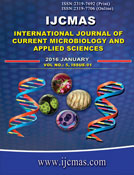


 National Academy of Agricultural Sciences (NAAS)
National Academy of Agricultural Sciences (NAAS)

|
PRINT ISSN : 2319-7692
Online ISSN : 2319-7706 Issues : 12 per year Publisher : Excellent Publishers Email : editorijcmas@gmail.com / submit@ijcmas.com Editor-in-chief: Dr.M.Prakash Index Copernicus ICV 2018: 95.39 NAAS RATING 2020: 5.38 |
A lysimeter experiment was constructed to evaluate the acquisition of nitrogen fertilizer applied in different rates and splitting doses (mode) by barley crop grown on sand soil under different irrigation water regime. Every lysimeter was backed with 90 kg of experimental sand soil. Fertilizer nitrogen as ammonium sulfate form enriched with 2% 15N atom excess was applied at rates of 120% (equal to 187.2 kg N ha-1 or 10.51 g N lys-1 ), 100% (equal to 156 kg N ha-1 or 8.76 g N lys -1 ) and 80% (equal to 124.8 kg N ha -1 or 7 g N lys -1 ) of the recommended rate (65 kg N fed-1 ). Nitrogen fertilizer rates were splitted into three modes of application as following: 33, 33, 33%; 40%, 30%, 30% and 50%, 25%, 25%. Three irrigation regimes: 60%, 80% and 100% of crop evapotranspiration (ETc). Straw yield was enhanced by of nitrogen fertilizer at N2 rate applied with S1 or S3. Plants irrigated with W1 followed by W3 water regimes achieved the remarkable values of straw yield. Root dry weight mainly significantly positively affected by irrigation water regimes and N fertilizer rates but not by mode of application. Irrigation with W2 regime combined with either N2 or N3 fertilizer rates applied at S3 splitting doses resulted in higher grain yield than other treatments. Application of W3 (60%) regime reflected straw-N uptake higher than those recorded with W2 but nearly closed to those of W1 regime. The overall means of N uptake by roots indicated superiority of N1 rate and splitting mode S3 but gradually decreased with N2 and N3 rates. Water regime W1 interacted with either N1 or N2 achieved the best values of N uptake by grains. The grand mean of N uptake by grains as affected by application modes pointed out no big significant difference between them. Nitrogen derived from fertilizer (Ndff) by straw was fluctuated due to splitting modes but generally, percentages of Ndff don't exceed 29% from the total N uptake by straw. There are no clear cut evident between water regimes when Ndff absolute values was considered. Ndff by roots was very low and values didn't reflect any significant difference between the tested treatments. Combined treatment of W1xN2xS3 was the best where it gave the remarkable Ndff values gained by grains as indicated by overall means of the tested factors. Generally, %NUE by straw of plants fertilized with N1 (187.2 kg N ha -1 ) rate surpass that of N2 (156 kg N ha -1 ) and N3 (124.8 kg N ha-1 ), rates. This holds true with different water regimes. Efficient use of N fertilizer as affected by water regime was equal in W1 and W3 (34.1%) and both were higher than W2 regime. Splitting dose mode superiority was dependent on water regime whereas %NUE of straw enhanced by S3 under W1 and W3 regimes while it was lower with W2 regime. Similar trend, but to somewhat low extent, was noticed with %NUE by roots. It was very low comparing to %NUE by straw. The best %NUE by grains was occurred with combined treatment of W1 x N1 x S3 achieving 67%. It seems the fertilizer-N was more efficiently used by grains followed by straw while roots recorded the lowest %NUE. In conclusion, growth and nitrogen fertilizer uptake by barley plants were, in general, enhanced by N1 (187.2 kg N ha -1 ) rate applied in splitting doses S3 (50, 25, 25) under 100% Etc water regime (W1).
 |
 |
 |
 |
 |